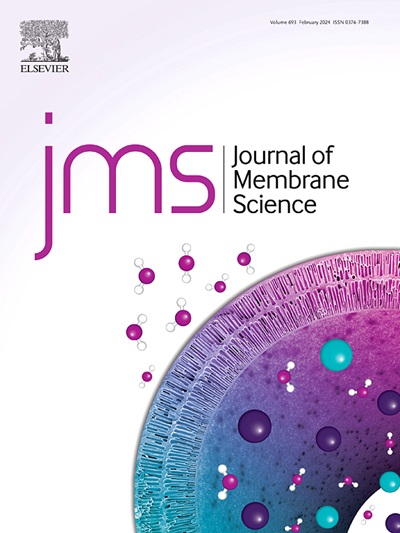悬浮静电纺丝和PDMS光诱导接枝用于油水分离的疏水/亲油纳米纤维膜
IF 9
1区 工程技术
Q1 ENGINEERING, CHEMICAL
引用次数: 0
摘要
本研究提出了一种简单有效的制备油/水分离用橡胶纳米纤维膜的方法。该工艺包括悬浮静电纺丝的苯乙烯-丁二烯橡胶(SBR)乳胶,然后是光诱导交联,以确保不溶性和形状的稳定性,以及光诱导接枝,以实现持久的疏水性和亲油性。在不同的功能化条件(如溶液浓度和浸泡时间)下,通过巯基反应将端乙烯基聚二甲基硅氧烷(PDMS)功能化剂接枝到纳米纤维上。FT-IR分析证实了成功的功能化:所得到的pdms接枝膜表现出定义明确、均匀的圆柱形纤维,平均直径为439 nm,具有高表面积和由部分熔融的橡胶纳米颗粒组成的结构。接触角测量表明,疏水性稳定(30分钟后水接触角为123°,24 h后油包水接触角为122°),亲水性强(油接触角为10°)。该膜有效地分离了油水,平均分离效率为99.3%,经过20次油/水混合物过滤后,油通量为988 L m−2 h−1。这些结果突出了疏水/亲油聚甲基丙烯酸甲酯功能化橡胶纳米纤维膜在含油废水处理和环境修复中的应用潜力。本文章由计算机程序翻译,如有差异,请以英文原文为准。

Hydrophobic/oleophilic nanofibrous membranes for oil/water separation by suspension electrospinning and PDMS photo-induced grafting
This study presents a simple and efficient method for fabricating rubber nanofibrous membranes for oil/water separation. The process involves suspension electrospinning of styrene-butadiene rubber (SBR) latex, followed by photo-induced crosslinking to ensure insolubility and shape stability, as well as photo-induced grafting to achieve durable hydrophobicity and oleophilicity. A vinyl-terminated polydimethylsiloxane (PDMS) functionalizing agent was grafted onto the nanofibers through a thiol-ene reaction, under various functionalization conditions (e.g., solution concentrations and immersion times). FT-IR analyses confirmed successful functionalization: the resulting PDMS-grafted membranes exhibited well-defined, uniform, cylindrical fibers with an average diameter of 439 nm, a high surface area, and a structure composed of partially fused rubber nanoparticles. Contact angle measurements demonstrated stable hydrophobicity (water contact angle of 123° after 30 min, water-in-oil contact angle of 122° after 24 h) and strong oleophilicity (oil contact angle <10°). The membranes effectively separated oil from water, achieving an average separation efficiency of 99.3 % and an oil flux of 988 L m−2 h−1 after 20 filtration cycles of an oil/water mixture. These results highlight the potential of hydrophobic/oleophilic PDMS-functionalized rubber nanofibrous membranes for oily wastewater treatment and environmental remediation applications.
求助全文
通过发布文献求助,成功后即可免费获取论文全文。
去求助
来源期刊

Journal of Membrane Science
工程技术-高分子科学
CiteScore
17.10
自引率
17.90%
发文量
1031
审稿时长
2.5 months
期刊介绍:
The Journal of Membrane Science is a publication that focuses on membrane systems and is aimed at academic and industrial chemists, chemical engineers, materials scientists, and membranologists. It publishes original research and reviews on various aspects of membrane transport, membrane formation/structure, fouling, module/process design, and processes/applications. The journal primarily focuses on the structure, function, and performance of non-biological membranes but also includes papers that relate to biological membranes. The Journal of Membrane Science publishes Full Text Papers, State-of-the-Art Reviews, Letters to the Editor, and Perspectives.
 求助内容:
求助内容: 应助结果提醒方式:
应助结果提醒方式:


